Cytochrome P450 metabolites of arachidonic acid play a role in the enhanced cardiac dysfunction in diabetic rats following ischaemic reperfusion injury
- PMID: 19302554
- PMCID: PMC2831291
- DOI: 10.1111/j.1474-8673.2009.00429.x
Cytochrome P450 metabolites of arachidonic acid play a role in the enhanced cardiac dysfunction in diabetic rats following ischaemic reperfusion injury
Abstract
1 This study examined the contribution of cytochrome P450 metabolites of arachidonic acid in mediating ischaemia/reperfusion (I/R)-induced cardiac dysfunction in normal and diabetic rats. 2 We first compared the metabolism of arachidonic acid in microsomes prepared from the hearts of control rats and rats treated with streptozotocin (55 mg kg(-1)) to induce diabetes. The production of dihydroxyeicosatrienoic acids and epoxyeicosatrienoic acids (EETs) were similar in microsomes prepared from the hearts of control and diabetic rats, but the production of 20-hydroxyeicosatetraenoic acid (20-HETE) was two-fold higher in diabetic hearts than in control animals. 3 We then compared the change in left ventricular pressure (P(max)), left ventricular end-diastolic pressure, coronary flow and coronary vascular resistance in isolated perfused hearts obtained from control and diabetic animals after 40 min of global ischaemia (I) followed by 30 min of reperfusion (R). The decline in cardiac function was three- to five-fold greater in the hearts obtained from diabetic vs. control animals. 4 Pretreatment of the hearts with N-hydroxy-N'-(4-butyl-2-methyl-phenyl)-formamidine (HET0016, 1 microm), a selective inhibitor of the synthesis of 20-HETE, for 30 min before I/R resulted in significant improvement in the recovery of cardiac function in the hearts obtained from diabetic but not in control rats. Perfusion with an inhibitor of soluble epoxide hydrolase, 1-cyclohexyl-3-dodecyl urea (CDU), before I/R improved the recovery of cardiac function in hearts obtained from both control and diabetic animals. Perfusion with both HET0016 and CDU resulted in significantly better recovery of cardiac function of diabetic hearts following I/R than that seen using either drug alone. Pretreatment of the hearts with glibenclamide (1 microm), an inhibitor of ATP-sensitive potassium channels, attenuated the cardioprotective effects of both CDU and HET0016. 5 This is the first study to suggest that acute blockade of the formation of 20-HETE and/or reduced inactivation of EETs could be an important strategy to reduce cardiac dysfunction following I/R events in diabetes.
Figures

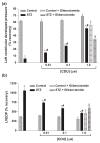
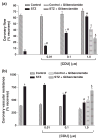
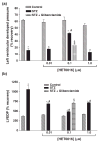
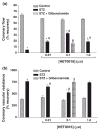
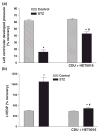

Similar articles
-
Role of cytochrome P450 metabolites of arachidonic acid in regulation of corporal smooth muscle tone in diabetic and older rats.Vascul Pharmacol. 2007 Nov-Dec;47(5-6):281-7. doi: 10.1016/j.vph.2007.08.002. Epub 2007 Aug 16. Vascul Pharmacol. 2007. PMID: 17855173
-
Hyperbaric oxygenation and 20-hydroxyeicosatetreanoic acid inhibition reduce stroke volume in female diabetic Sprague-Dawley rats.Exp Physiol. 2017 Dec 1;102(12):1596-1606. doi: 10.1113/EP086402. Epub 2017 Nov 2. Exp Physiol. 2017. PMID: 28940693
-
Role of 20-hydroxyeicosatetraenoic acid in altering vascular reactivity in diabetes.Auton Autacoid Pharmacol. 2009 Jan;29(1-2):1-12. doi: 10.1111/j.1474-8673.2009.00426.x. Auton Autacoid Pharmacol. 2009. PMID: 19302551 Free PMC article.
-
Meloxicam fails to augment the reno-protective effects of soluble epoxide hydrolase inhibition in streptozotocin-induced diabetic rats via increased 20-HETE levels.Prostaglandins Other Lipid Mediat. 2017 Sep;132:3-11. doi: 10.1016/j.prostaglandins.2016.08.004. Epub 2016 Sep 3. Prostaglandins Other Lipid Mediat. 2017. PMID: 27596333 Review.
-
Epoxyeicosatrienoic acids, 20-hydroxyeicosatetraenoic acid, and renal microvascular function.Prostaglandins Other Lipid Mediat. 2013 Jul-Aug;104-105:2-7. doi: 10.1016/j.prostaglandins.2013.01.002. Epub 2013 Jan 17. Prostaglandins Other Lipid Mediat. 2013. PMID: 23333581 Free PMC article. Review.
Cited by
-
Multi-omics insights into potential mechanism of SGLT2 inhibitors cardiovascular benefit in diabetic cardiomyopathy.Front Cardiovasc Med. 2022 Oct 5;9:999254. doi: 10.3389/fcvm.2022.999254. eCollection 2022. Front Cardiovasc Med. 2022. PMID: 36277768 Free PMC article.
-
Molecular mechanisms and cell signaling of 20-hydroxyeicosatetraenoic acid in vascular pathophysiology.Front Biosci (Landmark Ed). 2016 Jun 1;21(7):1427-63. doi: 10.2741/4465. Front Biosci (Landmark Ed). 2016. PMID: 27100515 Free PMC article. Review.
-
Effects of Arachidonic Acid Metabolites on Cardiovascular Health and Disease.Int J Mol Sci. 2021 Nov 6;22(21):12029. doi: 10.3390/ijms222112029. Int J Mol Sci. 2021. PMID: 34769460 Free PMC article. Review.
-
Determination of the dominant arachidonic acid cytochrome p450 monooxygenases in rat heart, lung, kidney, and liver: protein expression and metabolite kinetics.AAPS J. 2013 Jan;15(1):112-22. doi: 10.1208/s12248-012-9425-7. Epub 2012 Nov 10. AAPS J. 2013. PMID: 23139020 Free PMC article.
-
Elevated level of pro-inflammatory eicosanoids and EPC dysfunction in diabetic patients with cardiac ischemia.Prostaglandins Other Lipid Mediat. 2013 Jan;100-101:15-21. doi: 10.1016/j.prostaglandins.2012.12.002. Epub 2013 Jan 3. Prostaglandins Other Lipid Mediat. 2013. PMID: 23291334 Free PMC article.
References
-
- BATCHU SN, LAW E, BROCKS DR, FALCK JR, SEUBERT JM. Epoxyeicosatrienoic acid prevents postischemic electrocardiogram abnormalities in an isolated heart model. J Mol Cell Cardiol. 2009;46:67–74. - PubMed
-
- BENTER IF, FRANCIS I, COJOCEL C, JUGGI JS, YOUSIF MH, CANATAN H. Contribution of cytochrome P450 metabolites of arachidonic acid to hypertension and end-organ damage in spontaneously hypertensive rats treated with L-NAME. Auton Autacoid Pharmacol. 2005a;25:143–154. - PubMed
-
- BENTER IF, YOUSIF MH, CANATAN H, AKHTAR S. Inhibition of Ca2+/calmodulin-dependent protein kinase II, Ras-GTPase and 20-HETE attenuates the development of diabetes-induced vascular dysfunction in the rat carotid artery. Pharmacol Res. 2005b;52:252–257. - PubMed
-
- CAMPBELL WB, FALCK JR. Arachidonic acid metabolites as endothelium-derived hyperpolarizing factors. Hypertension. 2007;49:590–596. - PubMed
-
- CAMPBELL WB, GEBREMEDHIN D, PRATT PF, HARDER DR. Identification of epoxyeicosatrienoic acids as endothelium-derived hyperpolarizing factors. Circ Res. 1996;78:415–423. - PubMed
Publication types
MeSH terms
Substances
Grants and funding
LinkOut - more resources
Full Text Sources

